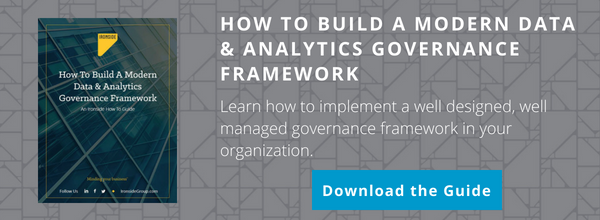Data & Analytics Governance: Change is Happening. Are You Ready?
Governance is the ongoing process of creating and managing processes, policies, and information. This includes strategies, processes, activities, skills, organizations, and technologies for the purpose of accelerating business outcomes. It also involves creating organizations, roles and responsibilities to perform this management. In our experience, many organizations address governance once and often without completing the necessary tasks. Organizations that excel in data and analytics governance continuously manage the process on an ongoing basis.

Governance is critical to shifting organizational culture to one of data-based decisions and outcomes. It’s not easy. Within the realm of analytics we commonly talk about two types of governance: Data and Analytic. Data and analytics governance is about leveraging data as an asset and reducing time and cost to insights. Data governance includes activities such as data definitions, discovery, data quality, and data lineage, and is what most Business Intelligence organizations think about when envisioning “governance.” Analytic governance involves focusing on both the tools used and how to manage them to unlock the value of data for the organization. It includes specific measurements and KPIs that drive the business. Governing these is just as important as governing the data.
More and more organizations are starting to see the value of data and analytics governance, and so are starting up related initiatives. Often, these initiatives come from IT, who sees issues with how data is being used and may be the front line for handling complaints about data quality. Other times, they may start with business users, who have their own perspective about data quality and their own issues with finding the data that they need. Both need to be involved, and they need to walk through the multiple steps required to create a holistic program. At Ironside we see three main subdomains:
Organization design is defining the structure of the governance groups themselves: who needs to be involved, timing of meetings, their decision making process, etc. There are many organizational models that can work – finding the one which matches an enterprise’s needs requires understanding company culture as well as business drivers behind the governance effort.
Process and change management takes the governance initiative to the rest of the enterprise. It includes communication and adoption of process and policy changes. Understanding who to approach with questions is just as important as creating the right policies. As with organization design, knowing company culture is critical to successful adoption.
Data integrity involves turning policies into concrete efforts. This can include data quality checks, master data management, data lineage repositories, data dictionaries – any implementation which enacts a governance decision. These efforts can be quick hits or lengthy initiatives. It’s important to understand the business value before embarking on any type of longer project.
There are many ways for governance efforts to go amiss. Here are the top three challenges we have seen in starting or sustaining governance efforts:
1. Once and Done
All enterprises change over time as business and analytic needs evolve. Moreover, we are in the middle of a massive trend toward rapid, self-service analytics. Business users and data analysts are looking to combine and explore data on their own in search of new insights. Reducing the time to business value creates a greater need for governance. It’s easy to run afoul of data issues, or to create dependencies on manual processes to sustain initial discoveries.

Many organizations create governance documents (such as data dictionaries or data quality rules) once, when a solution is being implemented. But while business processes change, the documentation often does not. As the accuracy of these items decreases, the business value of the documentation and the solution both fade. True governance requires an ongoing process to ensure that changes are understood and adopted.
This shift from a project-based to a process-based approach can be difficult. One way to make it easier is to focus on ease of maintenance when creating governance-related documents. Since there will be many updates over the lifespan of any documentation, any reduction in time required to make changes will improve the adoption rate as well as the productivity of the team making the updates.
2. Partial Participation
Creating and nurturing ongoing governance processes can be very challenging. Just bringing together all of the groups involved in creating, managing, and consuming data can be difficult, let alone convincing them of the importance of this type of effort. Without everyone’s perspective and buy-in, governance efforts will not succeed. For example, many data quality issues stem from data entry in transactional systems. Without participation from the data entry team, the likelihood of business process changes to reduce those issues is low.
Governance efforts are often initiated by IT groups who are seeking to improve adoption of analytics solutions. (Sometimes it is the reverse: a business group leads a governance effort in an attempt to improve their data, or their understanding of it.) Imposing governance as a set of rules on other groups is more likely to lead to resentment than successful adoption. An organization that is ready for governance understands the need to work together and the importance of sharing perspectives and priorities.
3. Missing Decision Rights
Governance is an ongoing, organization-wide effort. To coordinate such an effort requires a clear understanding of decision rights: what decisions are important, and who makes them. Some decisions are strategic and need to be made by a consensus of stakeholders (such as prioritizing domains for master data management). Some are very time-sensitive and should be assigned to individual stewards who have the bandwidth to address them as they arise (such as identifying failed customer matches in a key MDM pipeline).

Knowing what questions to ask is just as important as coming up with the right answers. It’s very common to miss the forest for the trees – that is, to focus on a particular aspect of governance without considering how that piece fits into larger priorities. Very often, the deliverable which comes up first ends up being a lower priority than others that are revealed along the way.
Perhaps the most important application of decision rights is focusing on areas which provide business value. Every domain does not need the same level of scrutiny. Many enterprise governance initiatives become bogged down in completing purely theoretical exercises (defining every single term in the company’s data systems, for example). Deciding which areas are of most benefit and therefore the highest priority ensures return on the organization’s investment.
What Next?
Succeeding at governance requires understanding its holistic nature. A governance organization involves stakeholders from across the enterprise, with an operating model that empowers the right individuals with the decision rights to sustain the business value of solutions and reduce time to insight. This organization can take many forms based on the nature of the enterprise and its business needs. Awareness of the need to identify, prioritize, and address change is the common factor.
Everything changes over time: data, systems, organizations, processes. Business analytics thrive only when they evolve to meet these changing needs. Governance organizations are the best way to recognize these changes, prioritize them, and make sure that the right part of the enterprise is tasked with addressing them. Without participation from everyone, these goals are unlikely to succeed.
About Ironside
Ironside was founded in 1999 as an enterprise data and analytics solution provider and system integrator. Our clients hire us to acquire, enrich and measure their data so they can make smarter, better decisions about their business. No matter your industry or specific business challenges, Ironside has the experience, perspective and agility to help transform your analytic environment.






